

Superb Tools for Everyday Tasks
• 10,000 Years of High-Precision Planetary Calculations from the state-of-the-art Swiss Ephemeris. Your choice of geo or helio charts; and tropical, draconic, or sidereal zodiacs with any ayanamsa of your choice.
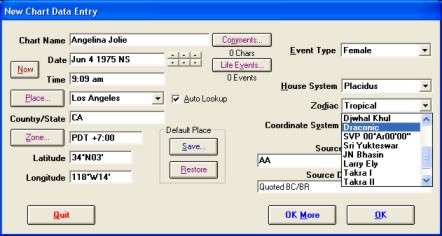
• 36 Standard Points are available throughout the program. These include Sun through Pluto, North and South lunar Nodes (mean or true), Part of Fortune (fixed or different day/night), Asc, MC, Vertex, and Equatorial Asc (“East Point”); Earth, Chiron, Ceres, Pallas, Juno, Vesta, Hygeia and Astraea; 8 Uranian planets, Transpluto, Vulcan (D. Baker or L.H. Weston version), and the Black Moon Lilith (mean position).
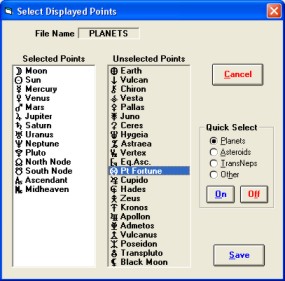
You can include any or all of these points in the main ring of wheels and in virtually all other options of Solar Fire, including the astro-location maps and planetarium view. You can create and save different point sets for different uses, and in Solar Fire’s lists and tables you can have the points arranged in the order that you prefer.
• Plus, More than 1,000 Extra Points, any of which can appear in special wheel rings and tables, in graphic and tabular ephemerides, and as natal, transiting and progressed points in the dynamic hitlists and time maps. Extra points supplied with Solar Fire 6 include all midpoints between the standard points; 290 fixed stars; the Jayne esoteric bodies Sigma, Pan, Isis, Morya, Hermes, Osiris, Midas and Lion; the Waltemath Dark Moon; and over 1,000 asteroids (from 5401BC-5399AD). (If you wish, you can input elements for additional orbiting bodies and coordinates for more stars.) You can assign each extra point a symbol and an abbreviation, and on chart pages you can add tables showing the meaning of the symbols, aspects that these points make, and other relevant information.
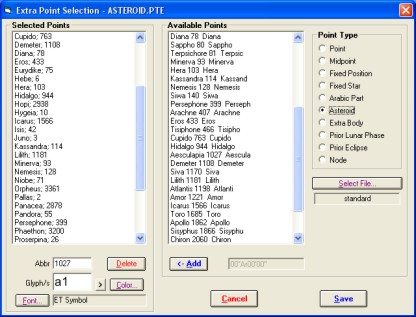
In addition, you can select from dozens of predefined Arabic parts or create new ones. You can include Arabic parts in special tables and wheel rings, and as natal points in dynamic hitlists, time map graphs and graphic ephemerides. You can also specify any fixed position (for example, the degree, minute and second of a sensitive point) and include it in special wheel rings; as a natal point in dynamic hitlists, time maps and graphic ephemerides; in return searches; and in chart-file and time searches. You can also look for intermediate house cusps in chart and time searches, and can include them as natal points in dynamic hitlists, time maps and graphic ephemerides. Plus, in tables and special wheel rings you can include prior eclipses or lunar phases and also geocentric or heliocentric planetary nodes.
• 30 House Systems include Placidus, Koch, Campanus, Meridian, Morinus, Porphyry, Regiomontanus, Topocentric, Whole Signs, Alcabitius and Hindu Bhava. There are also equal houses from the Ascendant; equal with the Ascendant in the center of the 1st; equal with any planet, the lunar north Node, the Part of Fortune, the Equatorial Ascendant, 0° Aries or 0° of the Sun sign on the 1st; and equal with the MC on the 10th or the Vertex on the 7th. Houses can be calculated for geographic or geocentric latitude. In addition, Gauquelin sector positions are available in tables and in the chart and electional searches.
• Built-in ACS Atlas with 250,000 places and time changes worldwide reduces data entry by a third, automatically filling in the longitude, latitude and correct time standard for the place and date. (In addition, a user-editable Solar Fire atlas lets you add your own place and time-change info. It also treats Australia in extra detail.)
• Generous Choice of Wheel and Page Graphics: Single, bi-, tri- and quad wheels in a variety of American, European, color-wash and other styles, with your choice of equally or proportionally spaced house cusps. Vedic and Western traditional square charts. Detailed aspect grids, and optional aspect lines in the wheels. Complex page designs with many kinds of useful tables and graphs. Plus, Solar Fire’s ingenious wheel- and page-editing screens let you create wheel and page designs of your own. Besides viewing and printing wheels and pages, you can export them as BMP, WMF, JPG, GIF or PDF files to insert in desktop publishing or email documents.
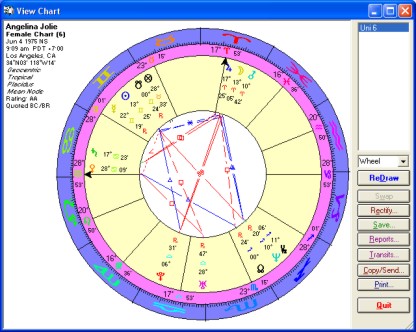


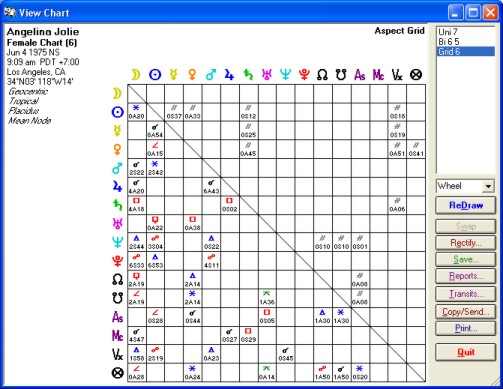
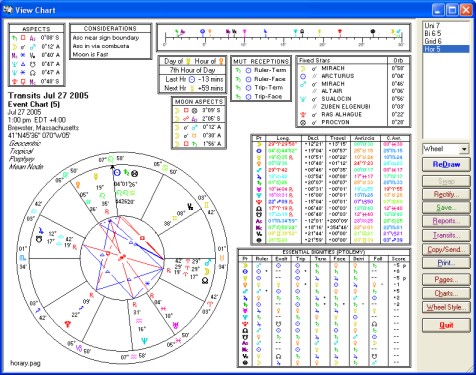
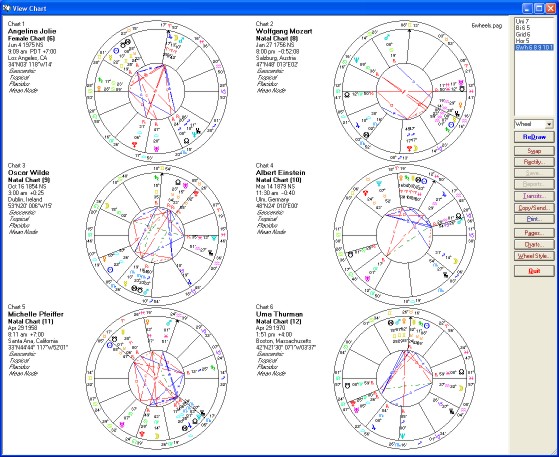

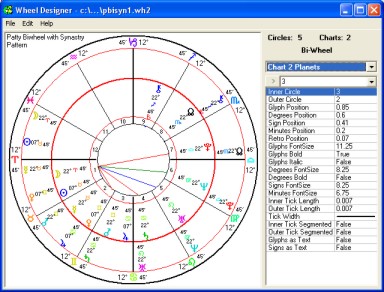
• Fantastic Aspect Support! 26 predefined aspects for the first 12 harmonics (conjunctions through semisextiles, plus septiles, noviles, undeciles and their multiples), and also parallels and contraparallels. Each predefined aspect has its own glyph, and can have its own color and line style. You can also define additional aspects with their own arc widths, orbs, colors, line styles and alphabetical symbols.
You can set different orbs for natal, transiting and progressed use, and different orbs for the luminaries vs. other points. Or, you can create different orbs for each individual pair of points by choosing Solar Fire’s “planet ratio” orbs. Other available ways of doing aspects include moieties, unidirectional, sign-to-sign, and “3-D” (off-the-ecliptic) aspects. You can create and store an unlimited number of different aspect sets for different purposes.

Screens and printouts can include 3 types of single-chart and synastry aspectarian grids showing how far the aspect is from being exact and whether it is applying or separating. In addition, there are tables showing aspect frequency analysis and aspects sorted by orb; also special tables of aspects involving just the Moon, asteroids, arabic parts or fixed stars. (For stars, many of which are far from the ecliptic, you can also see their angular relationships by using parans rather than aspects.) And now, with Solar Fire 6, you can tabulate and search for 25 types of multi-planet aspect patterns, from grand trines and t-squares to grand quintiles and sextiles, heles, rosettas and more.
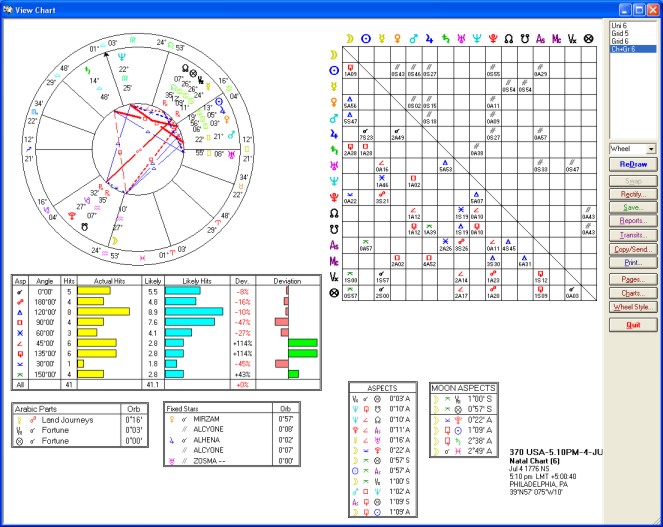
In the wheels, you can view the optional aspect lines in their chosen colors and line styles with or without aspect glyphs, and you can choose whether or not to draw aspect lines to any given planet. Selecting the new Aspect Highlighting further improves pattern recognition by making the lines grow wider as an aspect gets closer, and change to dotted lines when the aspect separates. You have a number of choices of how to do this. In addition, the new Aspect Filtering can make chosen aspect types or multi-planet patterns more apparent by temporarily filtering out all aspects except the type that you’re looking for. You can filter out all except a given harmonic, all except partile aspects, all except t-squares, etc. You can easily change criteria and you can easily switch the filter on and off.
• Time-Saving Task Recorder. With Solar Fire’s “Astrologer’s Assistant” task recorder, you can start recording your keystrokes and menu choices while you go through your most-used chart-casting routine. Then press Stop and review and edit the task. From that time on, all it takes is a couple of mouse clicks to apply the same complex sequence of operations to any base chart.


For personal use, you could use this Task Recorder to make the program start up by always calculating today’s transits and/or your progressed chart for the day. For professional use, you could automate your routine client prep -- so, for example, each time you cast a client’s natal chart you could also cast the client’s current progressed chart and solar return plus a year of transiting hits. Or you could record other complex tasks that you do often -- like progressing a composite chart, merging dynamic hitlists, or displaying a triwheel that includes all natal planets, only outer planets in the transiting ring and only inner planets in the progressed ring.
• Natal, Synastry, Transiting and Progressed Interpretations by Stephanie Johnson. You can get pop-up interpretations of individual aspects and other factors by clicking on planets and other items in the chart wheel or hitlist. You can also view, edit and print complete multi-page reports through your favorite word processor. If you wish, you can put your own stamp on the interpretations by rewriting and adding to the text database itself.
Solar Fire’s 25-page Natal Report includes short paragraphs about a very wide variety of factors -- not only planets in signs, houses and aspects, but also in degrees (Sabian Symbol and Ebertin-style medical meaning), decanates, elements, modes, quadrants and hemispheres. There is also text about house cusps, dispositors, rays, and lunar phases. Also, there are now sign and house interpretations for Chiron and the 6 standard asteroids, and aspect interps for Chiron.
Download a sample natal interpretation for Ron Howard (PDF FILE)
The Synastry Report does a romance and marriage reading from the aspect contacts between two charts, and it now includes Chiron aspects as well as aspects between the regular planets.
Download a sample synastry interpretation for Brad Pitt and Angelina Jolie (PDF FILE)
The Transiting and Progressed Reports provide a paragraph about each timed hit and ingress. There are now transiting interps for Chiron aspects and for the sign and house ingresses of Chiron and the 6 standard asteroids.
These reports aren’t intended for batch processing and commercial applications, but they’re great for getting your interpretive juices flowing, promoting your services, and giving to a client as an extra along with your consultation. And for beginners, they’re an easy and pleasant way to learn astrology.
• All Kinds of Forecasting Charts. Solar Fire 6 lets you cast all types and variations of forecasting charts and save them for future use. You can choose from:
Transiting Charts: Direct or converse, tropical, sidereal or precession-corrected.
Progressed Charts: By secondary, tertiary (mean or true), minor or user rate. MC progressed by solar or Naibod arc in either longitude or right ascension, or by Q2 (“daily houses”) rate. Progressed day type may be standard or Bija. Can also be direct or converse, tropical, sidereal or precession-corrected.
Directed Charts include solar, Ascendant, Vertex and user-defined arcs, and these can be direct or converse, with whole, half, double or reverse arcs.

Return Charts include returns of the Sun, Moon or any planet or standard asteroid to its natal or any other specified position. Returns can be tropical, sidereal or precession-corrected; direct or converse; full, demi, quarti, or any other harmonic; and you can do a whole string of returns from any starting date. Other types of return include progressed solar returns and Wynn Key Cycles.
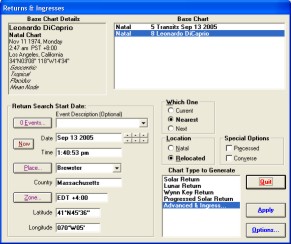
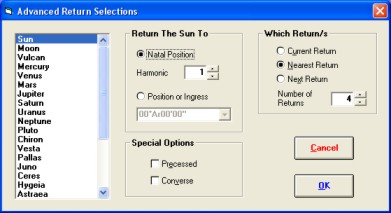
Lunar-Phase Charts include progressed and transiting lunar phases, eclipses, phase returns, and Pessin lunar phase families.
Age-Harmonic Charts create a harmonic chart for a given moment in someone’s life from the person’s exact age at the time. You can do these for the person’s age, or age plus one year.
You can view any forecasting chart either by itself or in a multi-ringed wheel along with the natal and other charts. You can also cast forecasting charts with extra points and view them using Solar Fire’s extra-points wheel rings and tables.
• Animated Charts let you put natal and forecasting charts on the same multi-wheel, and then click forward or back in time to watch the changes in the transiting, progressed and/or directed (and even profected) planets and aspects. Solar Fire 6’s new aspect highlighting feature makes the changes even more dramatic, thickening an aspect line as the aspect builds in intensity, and then changing it to a broken line as soon as the aspect separates. Not only can you animate chart wheels, you can also animate aspectarians and even whole pages in order to watch their tables of dignities, arabic parts, rays and a lot more change through time. You can also animate dials, get point-and-click interpretations, and print out any chart that you see on the screen. This simple and direct way of looking at charts could well become your favorite way to forecast!
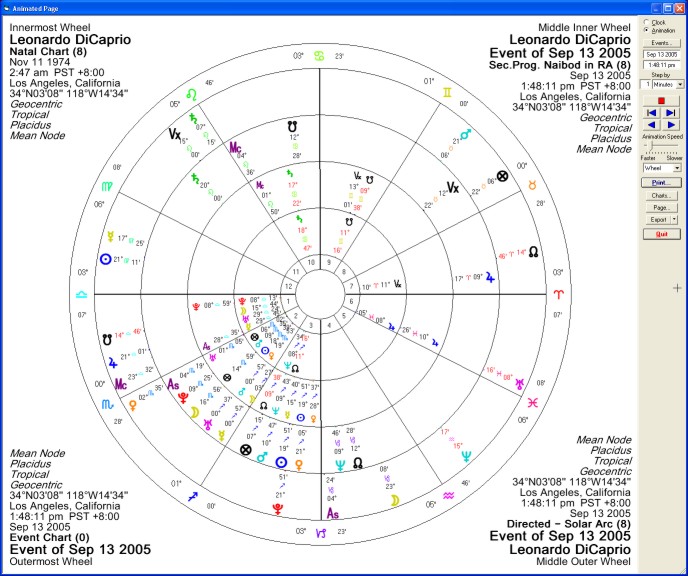
• Real-Time Chart shows you a wheel or page with constantly updating current planetary positions. To get it, you simply put the animated chart on automatic update. (This is in addition to the constantly updating planet, MC and Asc positions that you can have always visible on Solar Fire’s Main Screen.)
• Dynamic Hitlists are extraordinarily flexible and complete in Solar Fire 6. You can do transits (to natal, transiting, progressed or directed positions), progressions (secondary, tertiary, minor and user-defined, to natal or progressed positions), arc directions (solar, Ascendent, Vertex or user-defined whole, double, half or reverse arcs), sign and house ingresses, stations and eclipses. You can also include parallels of declination or latitude, primary directions (mundane or Van Dam), annual profections, and void-of-course Moon times. You can do any of these by themselves or mix them in one timed list, and you can gain even further flexibility by merging hitlists.
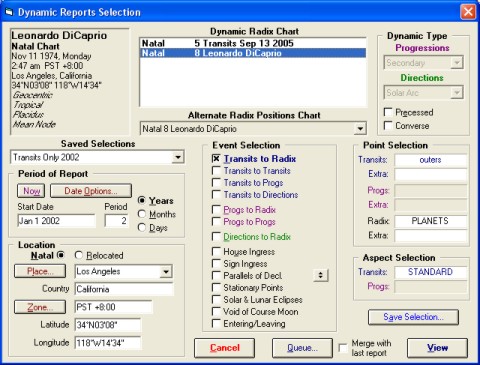
As points, you can include both moving and natal asteroids, hypothetical planets, midpoints, and even the moving Asc, MC, Vertex and Equatorial Ascendant. Plus, as natal points you can include intermediate house cusps, Arabic parts, and any fixed points that you specify. You can use different point sets for transits, progressions/directions, and the natal chart, and can use different aspects and orbs for transits vs. progressions/directions.
Other choices include natal or relocated; geo or helio; tropical, sidereal or precession-corrected; regular or converse; and timing to either the day or the minute. Once you set up all your selections for a given purpose, you can name and save them for future use.
Once a hitlist is calculated, Solar Fire’s sorting capabilities help you to make sense of it. Besides sorting timed hits in the usual chronological order, it’s useful to sort with the slowest-moving, most important transits first. Or sort by natal points to see how each factor in the chart is affected by the transits during that period. Or sort by the moving point to see what each moving point is doing to all the planets in a chart. Or group entering, exact and leaving dates together to see the whole course of each transit as it enters orb, perfects and separates. Or sort by type of aspect. Or sort transits, progressions, directions, ingresses, stations and eclipses into separate sections.
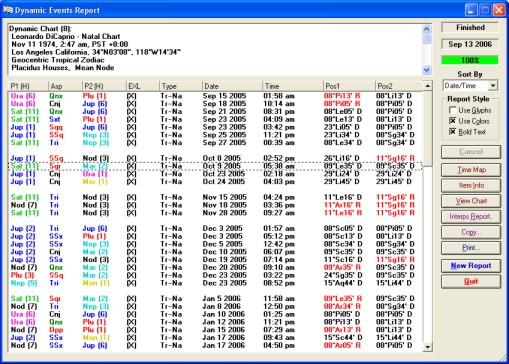
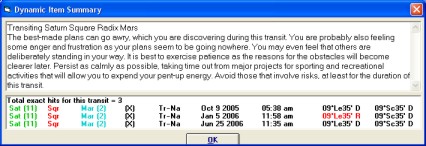
For more information about a hit, you can click on it to see other instances of the transit, a paragraph of interpretation, or a full chart wheel for the moment.
• Dynamic Interpretation Reports. In addition, for the entire period covered by the hitlist, you can view and print a multi-page transiting and/or progressed interpretation report. You can also copy just the hits themselves to a word processor or spreadsheet, where you can edit them, manipulate them in tables, etc.
Download a sample transit report for George Bush - July 1, 2005-June 30, 2006 (PDF FILE)
These reports aren’t intended for batch processing and commercial applications, but they’re great for getting your interpretive juices flowing, promoting your services, and giving to a client as an extra along with your consultation. And for beginners, they’re an easy and pleasant way to learn astrology.
• “Time Maps” show the whole hitlist in graphic form. Using a horizontal bar to indicate the duration of each event, these graphs make it easy to visualize how the transits, progressions, directions, and other events overlap in time.
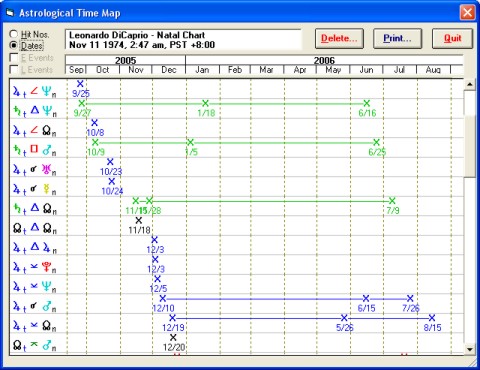
• Graphic Ephemerides: Ebertin-style graphs of planetary motion give you an additional way to make sense of transits, progressions or directions. Making it immediately obvious how fast each planet is traveling, and in what direction, they vividly depict planetary stations and complexes or “knots” of aspects. You can do graphic ephemerides with or without a natal chart, and you can view them not only in longitude (in 360-, 30-, 45-degree or any other modulus) but also in latitude and declination.

In Solar Fire 6 you can move the cursor to see the exact date and zodiacal degree of any point on the graph. Even better, you are free to scroll these graphs forward and back in time as much as you wish without needing to return to the selection screen.
• Custom Ephemeris Tables use state-of-the-art accuracy and go way beyond what you can get in books! Over any timespan and in whatever time zone and time intervals you choose, you can generate your choice of longitude, latitude, right ascension, declination, and daily motion not only for planets, but also for the MC, Asc, Part of Fortune, midpoints, regular and extra asteroids, stars and hypothetical points. You can do these in geo or helio coordinates; in the tropical, draconic or any sidereal zodiac. Your printouts can also include the sidereal time and day of the week, and they can be precise to either minutes or seconds of arc. You can also generate ephemerides in decimal-degree format for export to spreadsheets and other applications.
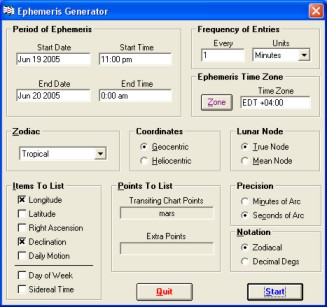
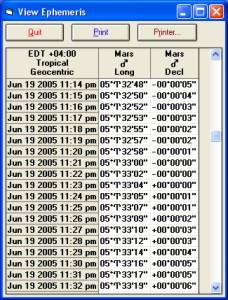
• Life-Event Lists attached to the natal chart make it easy to store and organize a person’s whole life history and keep adding to it whenever you wish. Just click on the main screen’s Chart Preview window to enter the dates and times of these events. From then on, they stand ready for instant recall as transiting, progressed or directed charts. Life-event lists also enable you to jump to the time of these events instantly in the animated chart view.
• Bi-Wheels include a “Biinter” wheel that has aspect lines going from one chart to the other, and a “Bizod” wheel that shows the house cusps of both people. You can also use the house cusps of the inner chart and easily swap the inner and outer charts to see the house cusps of the other person. For group analysis, you can put up to 4 charts in concentric rings on the same multi-wheel, or put up to 12 single wheels on the same page.
• Multiwheel Superimposition lets you line up the different rings of a multi-wheel using points other than the usual 0 Aries. For example, you could select a “Bizod”-type wheel style, and then use Superimposition to have the Ascendant of all the charts lined up on the left. You can also use Superimposition to see in-depth how one chart relates to the Sun, Moon or other point in another person’s chart.
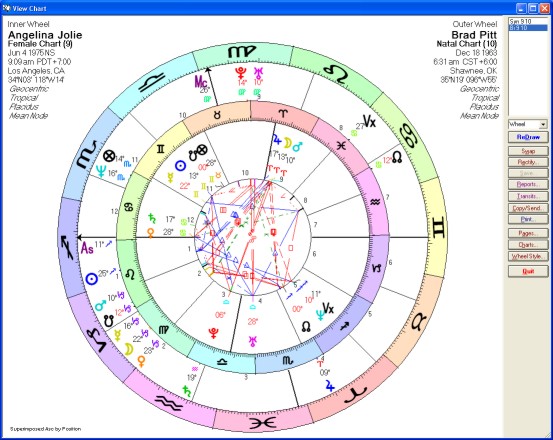
• Synastry Aspect Grids show cross-aspects between two charts, and how far they are from being exact.
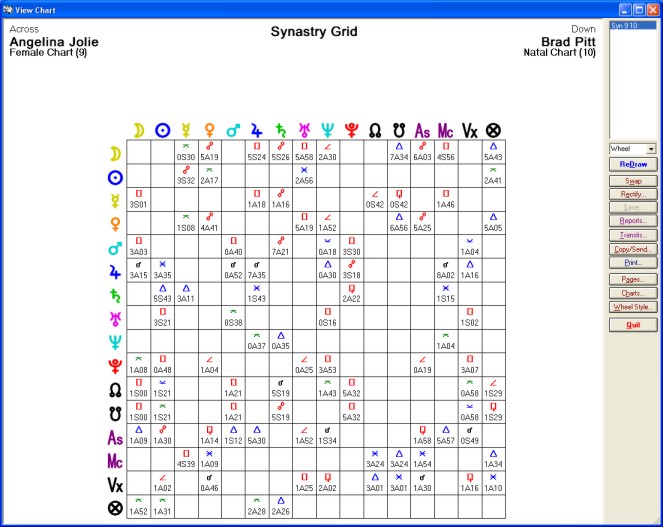
• Synastry Reports evaluate two natal charts for their love and marriage potential. You can also get on-screen point-and-click interpretations of individual synastry aspects.
Download a sample synastry interpretation for Brad Pitt and Angelina Jolie (PDF FILE)
• Combined Charts include composite charts of from 2 to 15 people. Also included are Davison and coalescent relationship charts.
• Dynamic Hitlists for Two. Solar Fire’s dynamic hitlists enable you to see the aspects that Person A’s progressed or directed planets make to Person B’s natal points. You could also do transiting hits to a composite chart or even to a composite of progressed charts.
• New Time and Chart Searches enable you to find either time periods or charts in your files that have harmonious planetary contacts with a given chart. This is a useful tool for a dating service or for finding someone who would be a desirable partner.
• Electional or Time Search. With Solar Fire 6, picking an auspicious beginning has never been easier! The new Electional Search feature finds time periods that meet whatever aspect, sign and other criteria that you specify. You can start with very simple criteria, and then keep adding more criteria to refine your search for the best possible planetary conditions in any specified time window. You can use the “And” connector to add criteria, the “Not” connector to exclude a given criterion, or the “Or” connector to include either of two criteria. You can save your complex criteria sets for future use, and can add to them whenever you please.
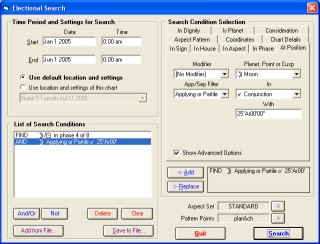
• Animated Chart. Alternatively, you can simply click your way through time until you spot a chart that you like. This is especially revealing when you use the new highlighted aspect lines to make the applying, exact and separating aspects stand out clearly. Besides animating a chart wheel, you can animate an aspect grid as well as tables of dignities, Arabic parts, midpoints and, in fact, virtually any page design.
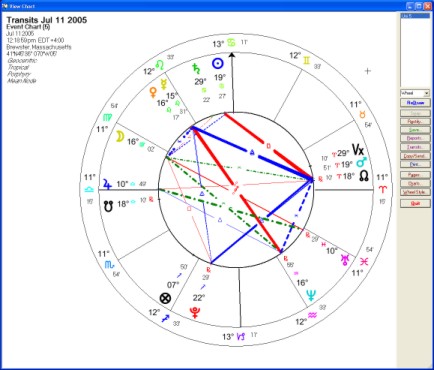
• Additional Electional Tools include Void of Course Moon listings, Moon phases, a full Planetary Hour table for any given day, ingresses, and returns of planets to any given position. You can also use the Rectification Assist window to fine-tune the time of a proposed electional chart to get just the right planetary relationships to the angles and Moon.
• Astro-Locality Maps have lines showing where on earth the planets at the birth moment would be rising, setting, culminating and anticulminating -- in other words, locations where the planets would tend to be particularly active. Choosing one of the 16 maps included in Solar Fire, you can project on it lines for any planet, asteroid or hypothetical body from Solar Fire’s regular point set. In addition, you can see the location of eclipse paths and print out local space charts.
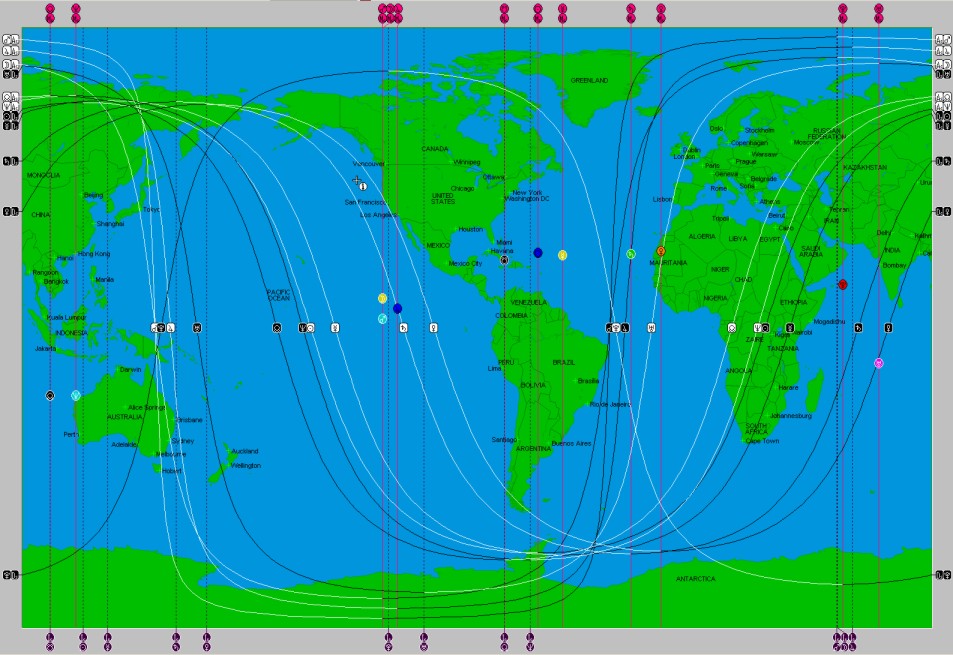
•
Local Space maps and wheels show azimuths (compass directions) of a chart’s planets as seen from any specified location. You can view these lines on the maps by themselves, or combine them with astro-mapping and eclipse lines.
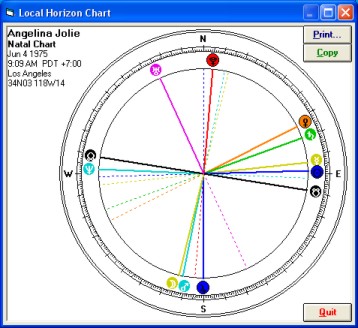
• Relocated Charts. Using Solar Fire’s “Locality” feature, it’s easy to recast a chart for as many different locations as you wish. Plus, in the regular chart view, you can use the “Rectify” button to nudge the chart’s longitude and/or latitude to get the Asc, MC and houses that you’re looking for.
• Geodetic and Johndro Charts adjust the MC of the natal chart according to a symbolic projection of the zodiac onto the Earth’s meridians. You can calculate either type of chart in longitude or right ascension. You can also specify the longitude on Earth where you want the zodiac to start.
• Life Event Lists keep all your rectification information handy so you can easily use it for fine-tuning a birth time or finding an unknown one.
• Animated Chart: Put the trial natal chart in the center surrounded by transiting (and possibly directed and progressed) rings. Then you can instantly jump these charts to the time of each life event in your list. Lets you quickly go through life events to see if the hits to the natal angles are consistently off by a certain number of degrees. If they are, you have good reasons for adjusting the natal chart.
• Rectification Assist. This window accessible from the static chart screen lets you watch a chart change as you adjust the time, date, Asc, MC, longitude or latitude. You can also put up a bi, tri or quad-wheel with the natal chart surrounded by transiting charts for life events. You can then use the Rectification Assist to nudge the time of the natal chart until you see appropriate contacts with the event charts.
System Requirements: IBM-compatible PC with a Pentium or higher processor or Mac running Virtual PC; 64Mbytes of RAM; CD-ROM drive, SVGA 800x600 or higher resolution modes with High Color; hard disk drive with at least 75Mb of free disk space; Windows 98, NT4, 2000 or XP. Solar Fire 4 is recommended for those who cannot meet these hardware requirements.
Price: $289 - Includes built-in ACS Atlas
Upgrade from v. 4, 5 or 5.1, $99/$114*
Upgrade from v. 2 or v. 3, $169 (includes manual)
Upgrade from v. 1 or Nova, $229 (includes manual)
*First price includes disk and an on-disk manual; second has printed manual added.
Want to Order Online?
Want to Order by Mail?
See our Order Form
For more info or to order call:
1-800-THE-NOVA
Return to Solar Fire Gold Main Page
![]() Getting the Most from Solar Fire with Madalyn Hillis-Dineen Instructional DVDs
Getting the Most from Solar Fire with Madalyn Hillis-Dineen Instructional DVDs